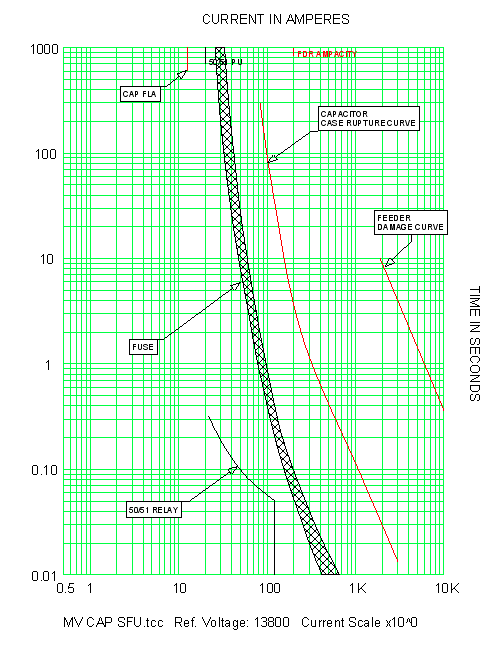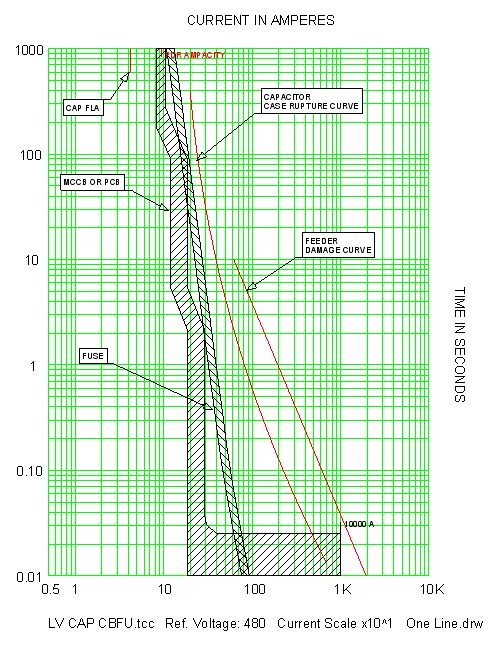Overcurrent Coordination Setting Guidelines Capacitors |
||||||||||||||||||||||||||||||||||
|
The information presented in this application guide is for review, approval, interpretation and application by a registered professional engineer only. SKM disclaims any responsibility and liability resulting from the use and interpretation of this information. Reproduction of this material is permitted provided proper acknowledgement is given to SKM Systems Analysis Inc. Introduction The proper selection and coordination of protective devices is mandated in article 110.10 of the National Electrical Code. To fulfill this requirement an overcurrent coordination study is required. The electrical engineer is always responsible for this analysis. It is an unfortunate fact of life that many times the engineer who specified and purchased the equipment will not set the devices. Therefore, compromises are inevitable. There are three fundamental objectives to overcurrent coordination that engineers should keep in mind while selecting and setting protective devices. |
||||||||||||||||||||||||||||||||||
| • The first objective is life safety. Life safety requirements are met if protective devices are rated to carry and interrupt maximum available load currents, as well as, withstand and interrupt maximum available fault currents. Life safety requirements are never compromised. • The second objective is equipment protection. Protection requirements are met if overcurrent devices are set above load operating levels and below equipment damage curves. Feeder and transformer damage curves are defined in applicable equipment standards. Motor and generator damage curves (points) are machine specific, and are normally provided in the vendor data submittal package. Based on system operating and equipment sizing practices equipment protection is not always possible. • The last objective is selectivity. Selectivity requirements are met if in response to a system fault or overload, the minimum area of the distribution system is removed from service. Again, based on system operating and equipment selection practices selectivity is not always possible. |
||||||||||||||||||||||||||||||||||
| Purpose | ||||||||||||||||||||||||||||||||||
| The purpose of this guide is to provide overcurrent protective device setting guidelines for capacitors to meet the objectives listed above. | ||||||||||||||||||||||||||||||||||
| MV Capacitor Switchgear Feeder Unit | ||||||||||||||||||||||||||||||||||
| Industry standard overcurrent protection schemes for MV fused capacitor banks fed from switchgear circuit breakers include an instantaneous overcurrent relay (device 50/51). The relay and fuse characteristics are plotted on a phase TCC along with the capacitor and feeder damage curves. The purpose of the breaker is to provide 3-phase switching. The purpose of the phase overcurrent relay is to allow for full use of the capacitor, and to protect the capacitor and cable from overloads, and the cable from faults. The relay-breaker combination is generally not fast enough to protect the capacitor from case rupture due to internal arcing faults. The purpose of the fuse is to provide the protection from case rupture. To accomplish this, the relay and fuse characteristics should be to the right of the capacitor amp rating, and to the left of the capacitor case rupture curve, cable damage curve and cable amp rating. Suggested margins are listed below that have historically allowed for safe operation of the transformer and cable while reducing instances of nuisance trips. |
||||||||||||||||||||||||||||||||||
|
||||||||||||||||||||||||||||||||||
 |
||||||||||||||||||||||||||||||||||
| Fig. 1 MV capacitor switchgear feeder unit - one line | ||||||||||||||||||||||||||||||||||
 |
||||||||||||||||||||||||||||||||||
| Fig. 2 MV capacitor switchgear feeder unit - phase TCC | ||||||||||||||||||||||||||||||||||
| LV Capacitor CB Feeder Unit Industry standard overcurrent protection schemes for LV capacitor banks fed from circuit breakers include fuses located in the capacitor enclosure. The circuit breaker and fuse characteristics are plotted on a phase TCC along with the capacitor and feeder damage curves. The purpose of the circuit breaker is to provide 3-phase switching, allow for full use of the capacitor, and to protect the capacitor and cable from overloads, and the cable from faults. The circuit breaker is not fast enough to protect the capacitor from case rupture due to internal arcing faults. The purpose of the fuse is to provide protection from case rupture. To accomplish this, the circuit breaker curve should be to the right of the capacitor FLA rating, and to the left of the cable damage curve and the cable amp rating. The fuse curve should be to the left of the capacitor case rupture curve. Depending upon the breaker long time pickup tolerance characteristics the breaker curve may be above the feeder ampacity at 1000 seconds. Suggested margins are listed below that have historically allowed for safe operation of the transformer and cable while reducing instances of nuisance trips. |
||||||||||||||||||||||||||||||||||
|
||||||||||||||||||||||||||||||||||
| Fig. 3 LV capacitor CB feeder unit - one line | ||||||||||||||||||||||||||||||||||
 |
||||||||||||||||||||||||||||||||||
| Fig. 4 LV capacitor CB feeder unit - phase TCC This Page Intentionally Left Blank |
||||||||||||||||||||||||||||||||||
| References | ||||||||||||||||||||||||||||||||||
| • Other Application Guides offered by SKM Systems Analysis at www.skm.com • Electrical Transmission and Distribution Reference Book, ABB Power T&D Company, Raleigh, North Carolina, 1997. |
||||||||||||||||||||||||||||||||||
| The latest revision of: | ||||||||||||||||||||||||||||||||||
| • IEEE Std C37.99, IEEE Guide for the Protection of Shunt Capacitor Banks • IEEE Std 18, IEEE Standard for Shunt Power Capacitors • IEEE Std 1036, IEEE Guide for the Application of Shunt Power Capacitors • NEMA Std CP-1, Shunt Capacitors |
||||||||||||||||||||||||||||||||||
| back to Application guides | ||||||||||||||||||||||||||||||||||